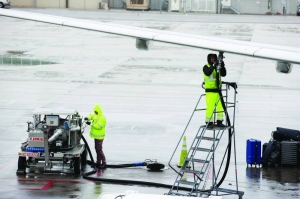Aviation industry faces dual challenge of managing rising fuel costs, navigating complex sustainability path


Ground operations employees fuel a plane. An escalation of war in the Middle East is very likely to cause a dramatic rise in oil prices and lead to spiralling jet fuel bill for airlines around the world.
The ongoing crisis has already injected volatility into global energy markets, raising concerns about the potential impact on fuel prices.
Industry experts point to the possibility of major disruptions in oil production and transportation, particularly in critical regions like the Strait of Hormuz, a vital channel for global oil shipments.
As fuel accounts for approximately 30% of airline operating costs, this issue has prompted airlines to intensify their efforts to improve efficiency and mitigate financial risks.
Efficiency improvements can come in various forms, such as modernising fleets with newer, more fuel-efficient aircraft, optimising operations, and urging governments to eliminate airspace and airport inefficiencies, which contribute to around 5% of fuel wastage annually.
A marginal increase in crude oil prices can significantly affect airline profitability, as fuel costs have historically accounted for 14% to 31% of operational expenses over the past decade.
In response to the volatile nature of fuel prices, airlines employ fuel hedging strategies, locking in fuel prices at favourable rates to shield themselves from sudden price spikes. They also focus on operational efficiency and fleet modernisation to reduce consumption.
Other strategies include flexible ticket pricing, schedule adjustments, and capacity management, all aimed at maintaining operational and financial stability in uncertain fuel markets.
But according to IATA, the global production of sustainable aviation fuel (SAF) is only about 100mn litres a year, or 0.1% of all aviation fuel used.
Various airlines have, however, committed to bringing this figure to 10% by 2030, a truly ambitious goal.
Airlines employ various strategies to manage the financial impact of fluctuating fuel prices.
Fuel hedging is a key tactic, allowing airlines to lock in fuel prices at favourable rates and shield themselves from sudden price spikes.
Additionally, airlines focus on operational efficiency improvements and fleet modernisation to reduce fuel consumption and lower costs.
Other strategies include adjusting ticket prices, flexible scheduling, and capacity management.
By implementing these measures, airlines aim to maintain operational stability and financial health despite volatile fuel markets.
Global body of airlines – IATA forecasts that the average cost of jet fuel in 2024 will be roughly $2.7095/gallon, up from the $2.6643/gallon average forecasted for 2023.
Meanwhile, oil futures jumped by almost 5% on Tuesday following reports that Iran had fired missiles at Israel. This escalation in Middle East tensions has sparked worries about possible disruptions to the global oil supply.
The growing conflict increases uncertainty in an already unstable energy market, where concerns about supply shortages often result in rapid price increases.
According to reports from Forbes, West Texas Intermediate (WTI) crude for November delivery rose by 4.7% to $71.31 per barrel, marking its largest one-day percentage increase since October 2023.
Brent crude for December delivery rose by 4.2%, reaching $74.71 per barrel.
This surge shows increasing concern among market players about the future of oil supplies from a region that contains some of the world’s biggest reserves.
Lower oil prices are certainly good for economic growth. Lower prices will also help curtail inflation and arguably allow central banks to loosen monetary policy further.
Such expectations are already contributing to weakening the US dollar to a 2024 low, which lends further support to growth in most of the global economy. Airlines will benefit on the demand side as GDP underpins air travel.
Moreover, as fuel represents around 30% of airlines’ costs, lower oil prices will shore up profits and might help expand the currently estimated slim 3% net profit margin for the industry in 2024, according to trade body IATA.
What the impact of the lower oil price will be on the relative appeal of investing in SAF production is hard to say. However, with the near 20% net margins in oil and gas production, chances are that SAF investments still need some essential policy support.
As the Middle East crisis unfolds, the aviation industry faces the dual challenge of managing rising fuel costs while navigating a complex path toward sustainability.



